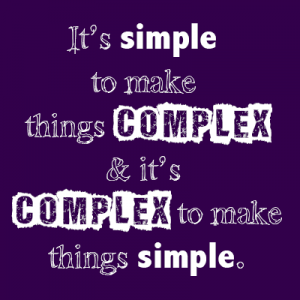Last week I spent a few days with innovative problem solvers from a group of large companies. Each of them recanted the difficulties they experienced when bringing new, innovative suggestions and solutions that could achieve more goals and solve problems. The resistance they said was fear. Fear of change. Fear of being wrong. Fear of failure.
Albert Einstein said, “Imagination is more important than knowledge. For knowledge is limited, whereas imagination embraces the entire world, stimulating progress, giving birth to evolution.” If you understand this quote you have one of he tools it takes to be a good problem solver. It is the ability to use the knowledge you have gained and combine it with your experience by applying it in a unique way to solve a problem.
Today we must take our knowledge and use it in the most productive way. Often you have to toss the rulebook, turn the paper sideways and write across the lines–look at things from a different angle.
Solving problems requires us to be familiar with its entry point, the part of the problem you first want to focus on. This requires us to explore more than one entry point or we come up with a solution to the wrong problem Let me explain.
It’s simple to make things complex,
but complex to make things simple.
Most Sundays I go to the Maxwell Street ‘Flea’ Market. A device sitting on a cluttered table filled partially hidden by some rusty tools and other ‘distressed’ items struck me. I stared for a minute and finally asked ‘what is this?’ Startled the vendor said, ‘trimmer, hedge trimmer.’ I fixated on the device. Where’s the blade I asked? Again, more stunned he said, can’t you see it? More determined I looked closer. The end was plastic and clearly something was missing, I reasoned.
Having just spent a few days immersed in innovative, problem solving techniques I could not see how the device could trim anything. Seeing my frustration, the vendor picked up the device and turned it around.
Looking at the ‘business end’ instead of the electrical coupling, I felt embarrassed. I had violated my own rules of engagement. Always look at a problem from 360 degrees.
Never limit yourself to a single viewpoint when you are attempting to solve a problem. I was so preoccupied with solving the problem; I did not get all the facts. I failed to ask an important question, “What is the primary goal, challenge or problem?” “What were my evaluation criteria?”I had allowed the vendor’s commentary to change my viewpoint taking me away from the ‘simple’ solution. I approached the problem in a linear way.
The entry point doesn’t have to be from the front end. It can, and should be, approached from other angles. Different entry points bring a variety of different solutions. Most people choose the most obvious, first entry point, because they believe other entry points will provide the same solution. I was guilty of trying to reach a creative solution before getting all the facts. I allowed emotion rather than logic to support my decision to discard important data.
Today commit to opening up your mind to more than one viewpoint when trying to solve a problem. Who knows? Maybe you will find a better way to prune obstructions that block your view. And leave the tree pruning to professionals.







